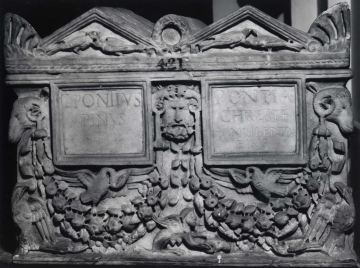Explore Collections


You are here:
CollectionsOnline
/
A Roman double funerary urn (cinerarium) wtih separate lid
Browse
A Roman double funerary urn (cinerarium) wtih separate lid
Pentelic marble
Height: 35cm
Height (excluding lid): 26cm
Width (lid): 47.5cm
Length (lid): 34.5cm
Height (excluding lid): 26cm
Width (lid): 47.5cm
Length (lid): 34.5cm
Inscription: 1) (LH side): L. PONTIVS / PINVS
L[ucius] Pontius Pinus
2) (RH side): PONTIA / CHRESTE / CONLIBERTA / EIVS
Pontia Chreste conliberta eius
Inscription marks: Faint traces of the lettercutter’s guidelines are visible.
1) Line 1: 17-20mm; Line 2: 15mm.
2) Line 1: 17-19mm; Line 2: 14mm; Line 3: 10-14mm; Line 4: 11mm.
Inscription note: We are grateful to Dr. Charlotte Tupman, a scholar of epigraphy (the study of inscriptions) undertaking postdoctoral research at King’s College London, who took squeezes of the inscriptions on antiquities in the Museum in 2007, for her transliteration, translation and notes/bibliography of the inscription on this piece.
Inscription translation: 1) Lucius Pontuis Pinus.
2) Pontia Chreste his fellow freed(woman).
L[ucius] Pontius Pinus
2) (RH side): PONTIA / CHRESTE / CONLIBERTA / EIVS
Pontia Chreste conliberta eius
Inscription marks: Faint traces of the lettercutter’s guidelines are visible.
1) Line 1: 17-20mm; Line 2: 15mm.
2) Line 1: 17-19mm; Line 2: 14mm; Line 3: 10-14mm; Line 4: 11mm.
Inscription note: We are grateful to Dr. Charlotte Tupman, a scholar of epigraphy (the study of inscriptions) undertaking postdoctoral research at King’s College London, who took squeezes of the inscriptions on antiquities in the Museum in 2007, for her transliteration, translation and notes/bibliography of the inscription on this piece.
Inscription translation: 1) Lucius Pontuis Pinus.
2) Pontia Chreste his fellow freed(woman).
Museum number: M421
On display: Catacombs
All spaces are in No. 13 Lincoln's Inn Fields unless identified as in No. 12, Soane's first house.
For tours https://www.soane.org/your-visit
Curatorial note
Between incised fillet mouldings at the front upper corners, either side of the name plates, are carved ram's heads. A garland hanging from each one meets the horns of an Ammon mask between them. Within the garlands, below the moulding around the name plates, are pendant geese with wings spread and necks bent. At the bottom centre, a Grecian sphinx faces left, with forepaws on a ram's head; at each lower corner is an eagle and a bird pecking at the garlands. The sides of the urn are carved with stylized palmettes; within each of the two pediments of the lid is pair of doves.
Inscribed:
Left name plate:
L.PONTIVS
PINVS
Right name plate:
PONTIA
CHRESTE
CONLIBERTA
EIVS
The family of which this couple were liberti was quite distinguished at several periods in Roman Imperial history. An L. Pontius was Praetor Urbanus in 20 AD; in the Flavian era a Pontius was a friend of the younger Pliny and was the recipient of three of his Epistles (V, 14; VI, 28 and VII, 4). According to information supplied by Dr. John Morris of University College, London from an unpublished Cypriote inscription, it appears that the father of this Pontius was a Proconsul. Finally, there are two L. Pontii mentioned in the early third century Album of Canusium (Corpus Inscriptionum Latinarum, IX, 338) who must be presumed to have held offices under the later Severans. The word CHRESTE indicates that she was a Greek liberta.
Inscribed:
Left name plate:
L.PONTIVS
PINVS
Right name plate:
PONTIA
CHRESTE
CONLIBERTA
EIVS
The family of which this couple were liberti was quite distinguished at several periods in Roman Imperial history. An L. Pontius was Praetor Urbanus in 20 AD; in the Flavian era a Pontius was a friend of the younger Pliny and was the recipient of three of his Epistles (V, 14; VI, 28 and VII, 4). According to information supplied by Dr. John Morris of University College, London from an unpublished Cypriote inscription, it appears that the father of this Pontius was a Proconsul. Finally, there are two L. Pontii mentioned in the early third century Album of Canusium (Corpus Inscriptionum Latinarum, IX, 338) who must be presumed to have held offices under the later Severans. The word CHRESTE indicates that she was a Greek liberta.
From Rome.
Literature
Corpus Inscriptionum Latinarum (C.I.L.), VI, iv.1, 24731.
Soane collections online is being continually updated. If you wish to find out more or if you have any further information about this object please contact us: worksofart@soane.org.uk





